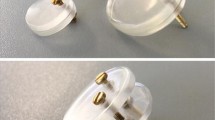Abstract
Keloid formation involving ears is commonly encountered in medical practice. There are variable treatment options with different outcomes particularly on recurrence. With treatment, there might be complications with varying severity. One of the commonest preferred treatment is intralesional steroid injection using triamcinolone acetonide (TCA). We encountered a complication of intralesional TCA injection when a patient who had an ear keloid developed gangrenous keloid involving the pinna after receiving a TCA injection that required surgical debridement. We believe such a complication has been underreported. We reviewed the literatures to highlight the complications following TCA injection of ear keloid.


Similar content being viewed by others
References
Watson D, Panuganti B. Treating scars in the auricle region. Facial Plast Surg Clin North Am. 2017;25(1):73–81.
Luo S, Benathan M, Raffoul W, Panizzon RG, Egloff DV. Abnormal balance between proliferation and apoptotic cell death in fibroblasts derived keloid lesions. Plast Reconstr Surg. 2001;107:87–96.
Alster TS, Tanzi EL. Hypertrophic scars and keloids: etiology and management. Am J Clin Dermatol. 2003;4(4):235–43.
Rosen DJ, Patel MK, Freeman K, Weiss PR. A primary protocol for the management of ear keloids: results of excision combined with intraoperative and postoperative steroid injections. Plast Reconstr Surg. 2007;120(5):1395–400.
Cheney ML, Tessa AH. Acquired deformities of the auricle. In: Nadol JB, Jr MJMK, editors. Surgery of the ear and temporal bone. 2nd ed. Philadelphia: Lippincott Williams & Wilkins; 2005. p. 593–4.
Griffith BH. The treatment of keloids with triamcinolone acetonide. Plast Reconstr Surg. 1966;38(3):202–8.
Muneuchi G, Suzuki S, Onodera M, Ito O, Hata Y, Igawa HH. Long-term outcome of intralesional injection of triamcinolone acetonide for the treatment of keloid scars in Asian patients. Scand J Plast Reconstr Surg Hand Surg. 2006;40(2):111–6.
Laisuan W, Wongsa C, Dchapaphapeaktak N, Tongdee M, Chatmapanrangsee J, Rerkpattanapipat T. Anaphylaxis following intralesional triamcinolone acetonide (kenacort) injection. Asia Pac Allergy. 2017;7(2):115–8.
Sukhumthammarat W, Putthapiban P, Sriphrapradang C. Local injection of triamcinolone acetonide: a forgotten aetiology of Cushing’s syndrome. J Clin Diagn Res. 2017;11(6):OR01–2.
Finken MJ, Mul D. Cushing’s syndrome and adrenal insufficiency after intradermal triamcinolone acetonide for keloid scars. Eur J Pediatr. 2010;169(9):1147–9.
Liu MF, Yencha M. Cushing’s syndrome secondary to intralesional steroid injections of multiple keloid scars. Otolaryngol Head Neck Surg. 2006;135(6):960–1.
Margaret Shanthi FX, Ernest K, Dhanraj P. Comparison of intralesional verapamil with intralesional triamcinolone in the treatment of hypertrophic scars and keloids. Indian J Dermatol Venereol Leprol. 2008;74(4):343–8.
Kumar P, Adolph S. Hypopigmentation along subcutaneous veins following intrakeloid triamcinolone injection: a case report and review of literature. Burns. 1998;24(5):487–8.
Abdel-Fattah AM. Unusual complications of triamcinolone injected keloids: tissue necrosis and systemic corticosteroid effects. Br J Plast Surg. 1976;29(4):283.
Camacho-Martínez FM, Rey ER, Serrano FC, Wagner A. Results of a combination of bleomycin and triamcinolone acetonide in the treatment of keloids and hypertrophic scars. An Bras Dermatol. 2013;88(3):387–94.
Amene PC. Activation of pulmonary tuberculosis following intralesional corticosteroids. Arch Dermatol. 1983;119(4):361–2.
Perdanasari AT, Lazzeri D, Su W, Xi W, Zheng Z, Ke L, et al. Recent developments in the use of intralesional injections keloid treatment. Arch Plast Surg. 2014;41(6):620–9.
Park TH, Chang CH. Location of keloids and its treatment modality may influence the keloid recurrence in children. J Craniofac Surg. 2015;26(4):1355–7.
Khan MA, Bashir MM, Khan FA. Intralesional triamcinolone alone and in combination with 5-fluorouracil for the treatment of keloid and hypertrophic scars. J Pak Med Assoc. 2014;64(9):1003–7.
Narakula GK, Shenoy RK. A prospective clinical review of “multi model” approach for treating ear keloids. Indian J Plast Surg. 2008;41(1):2–7.
Jung JY, Roh MR, Kwon YS, Chung KY. Surgery and perioperative intralesional corticosteroid injection for treating earlobe keloids: a Korean experience. Ann Dermatol. 2009;21(3):221–5.
Aluko-Olokun B, Olaitan AA, Ladeinde AL, Oginni FO. The facial keloid: a comparison of treatment outcome between intralesional steroid injection and excision combined with radiotherapy. Eur J Plast Surg. 2014;37(7):361–6.
Aluko-Olokun B, Olaitan AA, Ladeinde AL. Sessile and pedunculated facial keloid scar: a comparison of response to intralesional triamcinolone injection. Eur J Plast Surg. 2014;37(5):255–8.
Touchi R, Ueda K, Kurokawa N, Tsuji M. Central regions of keloids are severely ischaemic. J Plast Reconstr Aesthet Surg. 2016;69(2):e35–41.
Author information
Authors and Affiliations
Corresponding author
Ethics declarations
Conflict of Interest
The authors declare that they have no conflict of interest.
Ethical Approval
Not required for literature review and case report.
Informed Consent
Written informed consent obtained from the patient.
Additional information
Publisher’s Note
Springer Nature remains neutral with regard to jurisdictional claims in published maps and institutional affiliations.
This article is part of the Topical Collection on Surgery
Rights and permissions
About this article
Cite this article
Roy, S., Adaikappan, M., Letchumanan, P. et al. Gangrenous Keloid of the Ear Pinna Following Intralesional Triamcinolone Injection: Proper Consent Is Essential. SN Compr. Clin. Med. 1, 964–968 (2019). https://doi.org/10.1007/s42399-019-00146-6
Accepted:
Published:
Issue Date:
DOI: https://doi.org/10.1007/s42399-019-00146-6




